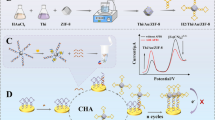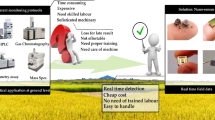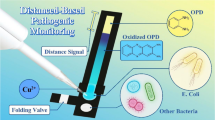Abstract
An innovative ultrasensitive electrochemical aptamer-based sensor was developed for ochratoxin A (OTA) detection in cold brew coffee through revolutionary combination of nanofibers, electrochemical method, and aptamer technologies. The assembly of the aptasensor was based on the activation of silanized cellulose nanofibrous membranes as a supporting matrix for methylene blue (MB) redox probe-labeled aptamer tethering. Cellulose nanofibrous membranes were regenerated by deacetylating electrospun cellulose acetate nanofibrous membranes with deacetylation efficacy of 97%, followed by silanization of the nanofiber surfaces by using (3-aminopropyl)triethoxysilane (APTES). A replacement of conventionally casted membranes by the nanofibrous membranes increased the active surface area on the working electrode of a screen-printed three-electrode sensor by more than two times, consequently enhancing the fabricated aptasensor performance. The developed aptasensor demonstrated high sensitivity and specificity toward OTA in a range 0.002–2 ng mL−1, with a detection limit of 0.81 pg mL−1. Moreover, the assembled aptamer-based sensor successfully detected OTA in cold brew coffee samples without any pretreatment. The aptasensor exhibited good reusability and stability over long storage time.

Graphical abstract






Similar content being viewed by others
References
Bisht S, Sisodia S (2010) Coffea arabica: a wonder gift to medical science. J Nat Pharm 1:58. https://doi.org/10.4103/2229-5119.73595
Meletis CD (2006) Coffee—functional food and medicinal herb. Altern Complement Ther 12:7–13. https://doi.org/10.1089/act.2006.12.7
Farah A, Donangelo CM (2006) Phenolic compounds in coffee. Braz J Plant Physiol 18:23–36. https://doi.org/10.1590/S1677-04202006000100003
Vignoli JA, Bassoli DG, Benassi MT (2011) Antioxidant activity, polyphenols, caffeine and melanoidins in soluble coffee: the influence of processing conditions and raw material. Food Chem 124:863–868. https://doi.org/10.1016/J.FOODCHEM.2010.07.008
Rao NZ, Fuller M (2018) Acidity and antioxidant activity of cold brew coffee. Sci Rep 8:16030. https://doi.org/10.1038/s41598-018-34392-w
Grand View Research (2019) Cold brew coffee market size, share, industry trends analysis report. https://www.grandviewresearch.com/industry-analysis/cold-brew-coffee-market
Vanesa D, Ana P (2013) Occurrence of Ochratoxin A in coffee beans, ground roasted coffee and soluble coffee and method validation. Food Control 30:675–678. https://doi.org/10.1016/J.FOODCONT.2012.09.004
Galarce-Bustos O, Alvarado M, Vega M, Aranda M (2014) Occurrence of ochratoxin A in roasted and instant coffees in Chilean market. Food Control 46:102–107. https://doi.org/10.1016/J.FOODCONT.2014.05.014
Coronel MB, Marin S, Cano G, Ramos AJ, Sanchis V (2011) Ochratoxin A in Spanish retail ground roasted coffee: occurrence and assessment of the exposure in Catalonia. Food Control 22:414–419. https://doi.org/10.1016/J.FOODCONT.2010.09.012
Chrouda A, Sbartai A, Baraket A, Renaud L, Maaref A, Jaffrezic-Renault N (2015) An aptasensor for ochratoxin A based on grafting of polyethylene glycol on a boron-doped diamond microcell. Anal Biochem 488:36–44. https://doi.org/10.1016/j.ab.2015.07.012
Rhouati A, Yang C, Hayat A, Marty J-L (2013) Aptamers: a promising tool for ochratoxin A detection in food analysis. Toxins (Basel) 5:1988–2008. https://doi.org/10.3390/toxins5111988
European Commission (2006) Setting maximum levels for certain contaminants in foodstuffs. Official Journal of the European Union. Commission Regulation (EU) no1881/2006. https://eur-lex.europa.eu/LexUriServ/LexUriServ.do?uri=OJ:L:2006:364:0005:0024:EN:PDF
European Commission (2010). Amending Regulation (EC) No 1881/2006 setting maximum levels for certain contaminants in foodstuffs as regards ochratoxin A. Official Journal of the European Union. Commission Regulation (EU) no105/2010. https://eur-lex.europa.eu/LexUriServ/LexUriServ.do?uri=OJ:L:2010:035:0007:0008:EN:PDF
Nakajima M, Tsubouchi H, Miyabe M, Ueno Y (1997) Survey of aflatoxin B1 and ochratoxin a in commercial green coffee beans by high-performance liquid chromatography linked with immunoaffinity chromatography. Food Agric Immunol 9:77–83. https://doi.org/10.1080/09540109709354938
Hayat A, Andreescu S, Marty J-L (2013) Design of PEG-aptamer two piece macromolecules as convenient and integrated sensing platform: application to the label free detection of small size molecules. Biosens Bioelectron 45:168–173. https://doi.org/10.1016/J.BIOS.2013.01.059
Wu J, Chu H, Mei Z, Deng Y, Xue F, Zheng L, Chen W (2012) Ultrasensitive one-step rapid detection of ochratoxin A by the folding-based electrochemical aptasensor. Anal Chim Acta 753:27–31. https://doi.org/10.1016/J.ACA.2012.09.036
Shan H, Li X, Liu L, Song D, Wang Z (2020) Recent advances in nanocomposite-based electrochemical aptasensors for the detection of toxins. J Mater Chem B 8:5808–5825. https://doi.org/10.1039/d0tb00705f
El-Moghazy AY, Soliman EA, Ibrahim HZ et al (2016) Ultra-sensitive biosensor based on genetically engineered acetylcholinesterase immobilized in poly (vinyl alcohol)/Fe–Ni alloy nanocomposite for phosmet detection in olive oil. Food Chem 203:73–78. https://doi.org/10.1016/j.foodchem.2016.02.014
Fu Q, Si Y, Duan C, Yan Z, Liu L, Yu J, Ding B (2019) Highly carboxylated, cellular structured, and underwater superelastic nanofibrous aerogels for efficient protein separation. Adv Funct Mater 29:1–11. https://doi.org/10.1002/adfm.201808234
Shuang Wu S, Wei M, Wei W et al (2019) Electrochemical aptasensor for aflatoxin B1 based on smart host-guest recognition of β-cyclodextrin polymer. https://doi.org/10.1016/j.bios.2019.01.022
Zhu X, Kou F, Xu H, Han Y, Yang G, Huang X, Chen W, Chi Y, Lin Z (2018) Label-free ochratoxin A electrochemical aptasensor based on target-induced noncovalent assembly of peroxidase-like graphitic carbon nitride nanosheet. Sensors Actuators B Chem 270:263–269. https://doi.org/10.1016/J.SNB.2018.05.048
Nan M, Bi Y, Xue H, Xue S, Long H, Pu L, Fu G (2019) Rapid determination of ochratoxin A in grape and its commodities based on a label-free impedimetric aptasensor constructed by layer-by-layer self-assembly. Toxins (Basel) 11:71. https://doi.org/10.3390/toxins11020071
Abnous K, Danesh NM, Alibolandi M, Ramezani M, Taghdisi SM (2017) Amperometric aptasensor for ochratoxin A based on the use of a gold electrode modified with aptamer, complementary DNA, SWCNTs and the redox marker methylene blue. Microchim Acta 184:1151–1159. https://doi.org/10.1007/s00604-017-2113-7
Wei M, Wang C, Xu E, Chen J, Xu X, Wei W, Liu S (2019) A simple and sensitive electrochemiluminescence aptasensor for determination of ochratoxin A based on a nicking endonuclease-powered DNA walking machine. Food Chem 282:141–146. https://doi.org/10.1016/J.FOODCHEM.2019.01.011
Wang Y, Ning G, Bi H, Wu Y, Liu G, Zhao Y (2018) A novel ratiometric electrochemical assay for ochratoxin A coupling Au nanoparticles decorated MoS2 nanosheets with aptamer. Electrochim Acta 285:120–127. https://doi.org/10.1016/J.ELECTACTA.2018.07.195
El-Khouly AS, Takahashi Y, Saafan AA et al (2011) Study of heavy metal ion absorbance by amidoxime group introduced to cellulose-graft-polyacrylonitrile. J Appl Polym Sci 120:866–873. https://doi.org/10.1002/app.33135
Martins NCT, Freire CSR, Neto CP, Silvestre AJD, Causio J, Baldi G, Sadocco P, Trindade T (2013) Antibacterial paper based on composite coatings of nanofibrillated cellulose and ZnO. Colloids Surf A Physicochem Eng Asp 417:111–119. https://doi.org/10.1016/J.COLSURFA.2012.10.042
Mandal B, Das D, Rameshbabu AP, Dhara S, Pal S (2016) A biodegradable, biocompatible transdermal device derived from carboxymethyl cellulose and multi-walled carbon nanotubes for sustained release of diclofenac sodium. RSC Adv 6:19605–19611. https://doi.org/10.1039/C6RA00260A
Derikvand F, Yin DT, Barrett R, Brumer H (2016) Cellulose-based biosensors for esterase detection. Anal Chem 88:2989–2993. https://doi.org/10.1021/acs.analchem.5b04661
Mao Y, Huang X, Xiong S, Xu H, Aguilar ZP, Xiong Y (2016) Large-volume immunomagnetic separation combined with multiplex PCR assay for simultaneous detection of Listeria monocytogenes and Listeria ivanovii in lettuce. Food Control 59:601–608. https://doi.org/10.1016/j.foodcont.2015.06.048
Amaly N, Ma Y, El-Moghazy AY, Sun G (2020) Copper complex formed with pyridine rings grafted on cellulose nanofibrous membranes for highly efficient lysozyme adsorption. Sep Purif Technol 250:117086. https://doi.org/10.1016/j.seppur.2020.117086
El-Moghazy AY, Huo J, Amaly N et al (2020) An innovative nanobody-based electrochemical immunosensor using decorated nylon nanofibers for point-of-care monitoring of human exposure to pyrethroid insecticides. ACS Appl Mater Interfaces 12:6159–6168. https://doi.org/10.1021/acsami.9b16193
El-Moghazy AY, Zhao C, Istamboulie G et al (2018) Ultrasensitive label-free electrochemical immunosensor based on PVA-co-PE nanofibrous membrane for the detection of chloramphenicol residues in milk. Biosens Bioelectron 117:838–844. https://doi.org/10.1016/j.bios.2018.07.025
Amaly N, El-Moghazy AY, Si Y, Sun G (2020) Functionalized nanofibrous nylon 6 membranes for efficient reusable and selective separation of laccase enzyme. Colloids Surf B Biointerfaces 194. https://doi.org/10.1016/j.colsurfb.2020.111190
Song J, Birbach NL, Hinestroza JP (2012) Deposition of silver nanoparticles on cellulosic fibers via stabilization of carboxymethyl groups. Cellulose 19:411–424. https://doi.org/10.1007/s10570-011-9647-3
Deng L, Young RJ, Kinloch IA, Abdelkader AM, Holmes SM, de Haro-del Rio DA, Eichhorn SJ (2013) Supercapacitance from cellulose and carbon nanotube nanocomposite fibers. ACS Appl Mater Interfaces 5:9983–9990. https://doi.org/10.1021/am403622v
Deng L, Young RJ, Kinloch IA, Zhu Y, Eichhorn SJ (2013) Carbon nanofibres produced from electrospun cellulose nanofibres. Carbon 58:66–75. https://doi.org/10.1016/J.CARBON.2013.02.032
Cruz-Aguado JA, Penner G (2008) Determination of ochratoxin A with a DNA aptamer. J Agric Food Chem 56:10456–10461. https://doi.org/10.1021/jf801957h
Liu H, Hsieh Y (2002) Ultrafine fibrous cellulose membranes from electrospinning of cellulose acetate. J Polym Sci Polym Phys 40:2119–2129
El-Moghazy AY, Soliman EA, Ibrahim HZ et al (2016) Biosensor based on electrospun blended chitosan-poly (vinyl alcohol) nanofibrous enzymatically sensitized membranes for pirimiphos-methyl detection in olive oil. Talanta 155:258–264. https://doi.org/10.1016/j.talanta.2016.04.018
Amiri P (2014) Electrospinning of poly (acrylonitrile-acrylic acid)/β cyclodextrin nanofibers and study of their molecular filtration characteristics. Fibres Text East Eur 22, 1(103):14–21
Pasternack RM, Rivillon Amy S, Chabal YJ (2008) Attachment of 3-(aminopropyl)triethoxysilane on silicon oxide surfaces: dependence on solution temperature. Langmuir 24:12963–12971. https://doi.org/10.1021/la8024827
Tao FF, Bernasek SL (2012) Functionalization of semiconductor surfaces. John Wiley & Sons INC, New Jersey
Seitz O, Fernandes PG, Tian R, Karnik N, Wen HC, Stiegler H, Chapman RA, Vogel EM, Chabal YJ (2011) Control and stability of self-assembled monolayers under biosensing conditions. J Mater Chem 21:4384. https://doi.org/10.1039/c1jm10132c
Yılmaz Baran N, Baran T, Menteş A (2017) Fabrication and application of cellulose Schiff base supported Pd(II) catalyst for fast and simple synthesis of biaryls via Suzuki coupling reaction. Appl Catal A Gen 531:36–44. https://doi.org/10.1016/j.apcata.2016.12.005
Qi X, Yoon H, Lee S-H, Yoon J, Kim SJ (2008) Surface-modified imogolite by 3-APS–OsO4 complex: synthesis, characterization and its application in the dihydroxylation of olefins. J Ind Eng Chem 14:136–141. https://doi.org/10.1016/J.JIEC.2007.08.010
Randles JEB (1948) A cathode ray polarograph. Trans Faraday Soc 44:322–327. https://doi.org/10.1039/tf9484400322
Eckhard K, Shin H, Mizaikoff B, Schuhmann W, Kranz C (2007) Alternating current (AC) impedance imaging with combined atomic force scanning electrochemical microscopy (AFM-SECM). Electrochem Commun 9:1311–1315. https://doi.org/10.1016/J.ELECOM.2007.01.027
Santaclara FJ, Pérez-Martín RI, Sotelo CG (2014) Developed of a method for the genetic identification of ling species (Genypterus spp.) in seafood products by FINS methodology. Food Chem 143:22–26. https://doi.org/10.1016/j.foodchem.2013.06.004
White RJ, Phares N, Lubin AA, Xiao Y, Plaxco KW (2008) Optimization of electrochemical aptamer-based sensors via optimization of probe packing density and surface chemistry. Langmuir 24:10513–10518. https://doi.org/10.1021/la800801v
Muthamizh S, Ribes À, Anusuyajanakiraman M, Narayanan V, Soto J, Martínez-Máñez R, Aznar E (2017) Implementation of oligonucleotide-gated supports for the electrochemical detection of Ochratoxin A. Supramol Chem 29:776–783. https://doi.org/10.1080/10610278.2017.1390238
De Girolamo A, McKeague M, Miller JD et al (2011) Determination of ochratoxin A in wheat after clean-up through a DNA aptamer-based solid phase extraction column. Food Chem 127:1378–1384. https://doi.org/10.1016/j.foodchem.2011.01.107
Guo X, Wen F, Zheng N, Saive M, Fauconnier ML, Wang J (2020) Aptamer-based biosensor for detection of mycotoxins. Front Chem 8. https://doi.org/10.3389/fchem.2020.00195
Funding
The research was partially supported by both USDA National Institute of Food and Agriculture (USDA-NIFA) program (Grant No. 2015-68003-23411) and National Institute of Environmental Health Sciences (NIEHS) (Grant No. 5P42ES004699).
Author information
Authors and Affiliations
Corresponding authors
Ethics declarations
Conflict of interest
The author(s) declare that they have no competing interests.
Additional information
Publisher’s note
Springer Nature remains neutral with regard to jurisdictional claims in published maps and institutional affiliations.
Electronic supplementary material
ESM 1
(DOCX 795 kb).
Rights and permissions
About this article
Cite this article
El-Moghazy, A.Y., Amaly, N., Istamboulie, G. et al. A signal-on electrochemical aptasensor based on silanized cellulose nanofibers for rapid point-of-use detection of ochratoxin A. Microchim Acta 187, 535 (2020). https://doi.org/10.1007/s00604-020-04509-y
Received:
Accepted:
Published:
DOI: https://doi.org/10.1007/s00604-020-04509-y




